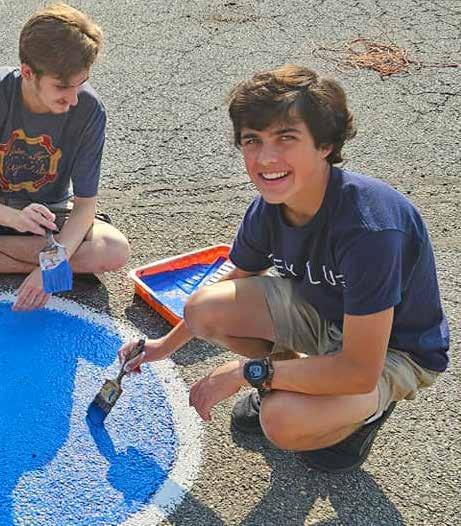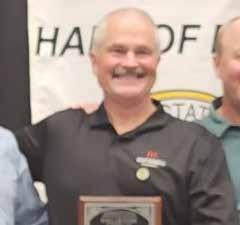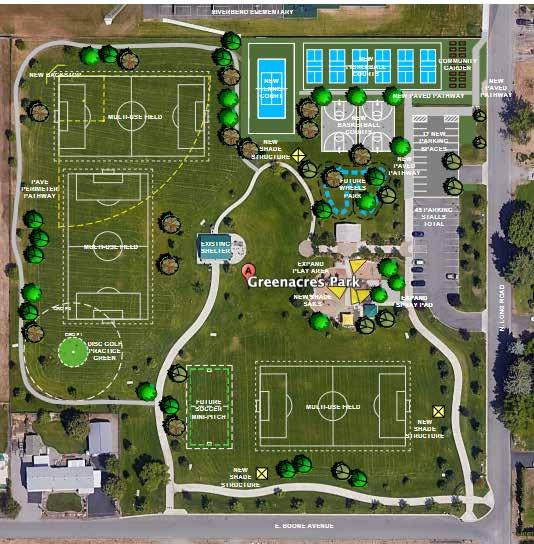








By Matthew Stephens
Current contributor
At just 16 years old, Gavin Ahumada has already made a significant impact on his school and community through his leadership in Key Club, the world’s largest student-led high school volunteer organization. As Lieutenant Governor (LTG) for Division 46, Ahumada has taken on the challenge of strengthening the club's network, increasing membership, and fostering a culture of service across multiple communities in Eastern Washington.
Ahumada, a junior at University High School, has always been service-minded. Growing up in a family of educators, including his parents and aunt, he was instilled with the values of giving back and helping others. When he first learned about Key Club as a freshman, he immediately set a goal to join and become actively involved. That opportunity presented itself in his sophomore year when he successfully stepped into the role of LTG for Division 46.
Founded in 1925 in Sacramento, California, Key Club has grown into a global organization with over 270,000 members in 38 countries. It is a student-led branch of Kiwanis International, focused on developing leadership through service. Each club operates under a faculty or Kiwanis advisor and sets its own priorities based on the community's needs.
According to Area Administrator Ashleigh Hathaway, Key Club plays a crucial role in engaging students in service projects that reflect their community’s needs. Clubs at each school decide on their focus areas, which often include initiatives
such as fundraising for local food banks, assembling hygiene kits for shelters, and volunteering at soup kitchens. In previous years, Key Club members have also raised money for children’s cancer research, constructed deep bore wells for clean drinking water, and championed youth mental health awareness.
“In the 10 years I have been an Area Administrator, Gavin is, hands down, one of my favorites. He took on the role of Lt. Governor (LTG) as a sophomore and has done an amazing job bringing division 46 together, through division wide events (Eastside Rally at Silverwood), projects (Food Drive with Liberty Lake Kiwanis), and
engaging with each individual club,” Hathaway said. “Gavin’s role as LTG is to act as a liaison between the Pacific Northwest (PNW) Key Club District and all the Key Clubs in his division. He has a lot on his plate, managing 11 clubs while also working to establish two new Key Clubs.”
“His division spans a geographically large area, including Liberty Lake, Spokane Valley, Spokane, Deer Park, Cheney, and Medical Lake. Historically, it has been difficult to maintain a Lieutenant Governor for Division 46 because of the workload, but Gavin knew the challenges and jumped right in. And I’ve been impressed every step of the way,” she added.

She said she has seen more growth and district involvement in the last year then she has seen in the past 5 years.
“Overall, participation at district and divisional events has increased tenfold, between the Eastside Rally, officer training and his food drive are just a few examples,” Hathaway said. “Membership is up. He is (and has been) in direct communication with the 11 Key Clubs and their Faculty/Kiwanis Advisors, all the local Kiwanis Clubs and school administrators.”
University High School Key Club Advisor Rick Pettibone echoed Hathaway’s praise for Ahumada’s dedication and leadership. “Gavin is a rock star and deserves all the credit for his efforts,” Pettibone said. His ability to mobilize students, coordinate with multiple organizations is outstanding according to his mentors, and truly makes a difference in the community.
Ahumada attributes his ability to manage all of these responsibilities to the tremendous support system he has at home, school, and within the community. He acknowledges that without the encouragement of his parents, teachers, fellow students and local Kiwanis members, he would not have been able to accomplish as much as he has. Their guidance and belief in his abilities have motivated him to push forward and take on even greater challenges.
Division 46 is not the only Key Club division making an impact in the region. Division 48, which covers North Idaho, has been focusing on projects such as community clean-up initiatives and mentorship programs for middle school students. Other divisions in the Pacific Northwest Key Club District, including those in Seattle and Portland, have contributed significantly to disaster relief efforts, environmental sustainability projects, and scholarships for underprivileged students.
One of Ahumada’s proudest





Valley High School’s Annual
Sunday, March 23rd, 2025, at 10:00 am East Valley High School, 15711 E Wellesley, Spokane, WA
The Rapid Rabbit Run is a yearly fund raiser for East Valley High School’s Senior All Knighter.
USATF certified. Run a 5-mile road race (second seed Bloomsday qualifier) or 3-mile (places only) run.

5 mile Road Race: Second seed Bloomsday qualifier
3 mile Run: Places only
TIME: 10:00 a.m.; packet pick up starts at 8:45 on race day ENTRY FEE: $25 with shirt $20.00 without shirt. Shirt Only: $15









Continued from page 2
accomplishments as LTG was organizing a highly successful food drive with the Liberty Lake Kiwanis. Under his leadership, the club collected over 700 pounds of food that went to 2nd Harvest Foods to help those experiencing food insecurity.
His main goal stepping into the position was to expand the club’s network and increase awareness of Key Club’s mission, and the results speak for themselves.
Beyond local efforts, Ahumada has also been instrumental in securing opportunities for students to attend the upcoming PNW District Convention (DCON), an annual gathering that brings together Key Club members from across the region. According to Hathaway, Ahumada has worked diligently for months to ensure strong local representation at DCON.
“Right now, it looks like seven local Key Clubs will be sending delegates to DCON,” Hathaway said. “This year was expected to be a rebuilding year for attendance, and some schools could only send two students. But Gavin didn’t let that deter him. He worked tirelessly to make it possible for more students to attend.”
Ahumada secured two faculty advisors from Ridgeline High School to chaperone students from other schools, ensuring that clubs without faculty representation could still participate. Additionally, he worked with local Kiwanis clubs to help fund the cost of attending the convention. The Liberty Lake Kiwanis Club, in particular, stepped up by covering the full cost for their
two Key Clubbers to attend, as well as offering to fund transportation for all Division 46 Key Clubbers traveling to the event.
“Because of the stellar relationships he has been able to develop, Gavin has coordinated transportation for both Division 48 (North Idaho) and Division 46 (Eastern Washington), making it possible for even more students to experience DCON,” Hathaway added.
With his term as LTG set to end on April 1, Ahumada is already looking ahead. He plans to run for the position of Key Club Governor, an even larger leadership role within the organization. His longterm aspirations extend beyond high school as well—he envisions a future in politics, with goals of working at an international level, including with the United Nations.
“One of my favorite quotes is to shoot for the moon,” Ahumada said. “Because even if you miss, you’ll end up with the stars.”
Hathaway believes Ahumada’s leadership and service-oriented mindset are far beyond his years. “Gavin is wise beyond his years; he tackles each situation or challenge so thoroughly that I often forget he is still in high school,” she said. “He has been able to serve his community so well as LTG, and that is on top of excellent grades, AP courses, ASB involvement, and Track.”
Ahumada remains focused on ensuring that his efforts create a lasting impact. He hopes the momentum he has built within Division 46 will continue long after he graduates.
“I just want to leave the world a better place with my efforts,” Ahumada said. “So that’s what we’re doing.”



By John McCallum
Current contributor
As one of its final actions of 2024, the Spokane Valley City Council took the seldom used step of discipling one of its members because of acts committed in violation of the council’s Governance Manual.
At the Dec. 19 special meeting, council voted 6-0 to censure Councilman Al Merkel and strip him of all committee assignments as a result of an investigation and hearing examiner’s decision into Merkel’s use of his Nextdoor social media account to conduct City Council business. Complaints about Merkel’s use of his account were made in June by Councilwoman Jessica Yaeger and a subsequent investigation by an independent, city-hired investigator upheld those complaints.
The investigator, Seattle-based attorney Rebecca Dean, determined Merkel violated City Council policy by posting city business on his Nextdoor account that was not connected to an official city email address or archiving system, and in several cases had edited emails to remove some citizen responses. When notified of this, Merkel failed to produce emails deemed “likely public records” connected to city business, and then revised and signed a declaration that he does not possess any public records on his Nextdoor account.
While the investigation listed one individual as a third-party requestor of the applicable records from Merkel’s account, as of the end of November, 2024, the city had received 54 public records requests relating to Merkel, amounting to 14% of all public records requests received to date.
City Attorney Kelly Konkright told council Merkel’s behavior regarding the emails potentially exposed the city to lawsuits from individuals and organizations seeking access to those records but being denied. He also said the councilman had received training on public records on three separate occasions before Yaeger’s complaint.
Merkel requested an appeal of the findings, and per city policy, Spokane County Hearing Examiner Andrew
Kottkamp conducted a hearing on Oct. 24. Kottkamp’s decision, released in early December, upheld the investigation’s findings and recommended council censure Merkel, and if the behavior persisted, potentially remove him from committee assignments.
At the Dec. 19 meeting, the City Council did both.
Before blasting the investigation, Kottkamp’s decision and City Council action, Merkel said he agreed to allow the city to set up a program on his Nextdoor account through which emails can be saved as public records.
In a prepared statement, Merkel said the “independent process was anything but independent” while continuing to claim he had done nothing wrong, reprimanding the council and City Manager John Hohman for wasting the public’s time and resources while issues such as public safety, unneeded road projects and over taxation such as the city’s vehicle license tab policy went unattended.
Both Mayor Pam Haley and Deputy Mayor Tim Hattenburg disputed Merkel’s claim. Haley said the specific road project Merkel referenced, Sprague Avenue stormwater and road improvements, was paid for by stormwater funds derived from fees for that purpose.
Hattenburg pointed to the council’s recent moves to increase the city’s police force, adding businesses often cite quality infrastructure as their reason for locating in Spokane Valley.
“He (Merkel) came to council to burn the city down, and you’re going to pay for it,” Haley said.
As of a Jan. 15, 2025 report, the city had spent $235,047.75 on issues surrounding Merkel. Almost $119,910 has been spent on the public records issue, while $95,391 was spent on actions to “protect city employees” after another investigation earlier in 2024 determined Merkel had made threatening and intimidating remarks and actions towards city staff.
“Quite frankly, this makes me sick,” Yaeger said of the expenses. “The victims here are the citizens of Spokane Valley.”
Greenacres Park upgrades approved
At the Jan. 21 meeting, council passed a resolution awarding the Greenacres Park Phase 2 improvements to Cameron Reilly, LLC of Spokane. Cameron Reilly was the lowest of four bidders on the project with a base bid of $1,082,500.
The bid included pricing for three alternates, two of which — basketball

Spokane Valley Councilwoman Jessica Yaeger makes a point during discussions on the city’s proposed ordinance dealing with private property camping.
courts and divider fences for pickleball courts — were included in the final award of $1,177,500. A $50,000 alternate for soccer pitches was postponed to a later date so city staff could coordinate with the RAVE Foundation Board for funding a soccer mini-pitch.
The project, located adjacent to Riverbend Elementary School off East Mission, was funded with two grants from the Washington State Recreation and Conservation Office totaling $1.5 million. The city is using $500,000 from the Capital Reserve Fund.
Council voted 6-1 to award the contract, with Merkel voting no.
City to pursue RAISE funds for Sullivan / Trent
Council voted 6-1 at the Jan. 14 meeting to authorize staff to apply for $25 million from the federal Rebuilding American Infrastructure with Sustainability and Equity (RAISE) program for use on its proposed nearly $53.77 million Sullivan / Trent Interchange project. Engineering manager Adam Jackson told council $1.5 billion is available nationwide in the program, and it’s the third time the city has sought this funding for the project.
The city has already secured $5.65 million in federal funding along with committing $881,792 of city funds to the project. Award of the RAISE funding would leave $17.4 million of project costs needing to be secured, of which $8.9 million would need to be nonfederal funds.
As he has with other projects utilizing some city funds, Merkel voted no, saying the city should focus on other needs such as public safety before pursing these types of projects. Wick disagreed, saying the Sullivan / Trent
interchange needs upgrading because of increasing traffic flow from area development and the newly finished Bigelow Gulch corridor.
“We’ll take cash or check,” Wick said.
Valley hires more cops
The council voted unanimously at its Jan. 7 meeting to authorize the hiring of 10 additional positions in the city’s Police Department. While council had authorized the hiring in February, the exact makeup of the positions was subject to a Police Department staffing needs analysis.
The city will execute an amendment to its Law Enforcement Services Interlocal Agreement with the Spokane County Sheriff’s Office to hire four patrol deputies, one patrol lieutenant, one traffic deputy, one homeless services deputy, two Spokane Valley Investigative Unit detectives, one Spokane Valley Investigative Unit sergeant and modify one patrol sergeant to patrol lieutenant.
The positions, along with about 20 more, were recommended by a police staffing report by Matrix given in November, 2023. In February, 2024, council allocated $2.125 million from the General Fund normally targeted for street maintenance for the positions using a funding mechanism to replace the transferred street funding that is heavily dependent on the Transportation Benefit District’s licensing fee and the streetwear fees received under the solid waste collection contract.
Approved by council in December, 2023, the TBD tab fees are estimated to bring in $2.8 million in 2025 while the streetwear fee is estimated at $1.7 million.

Central Valley High School Senior Annabella Everano has a heart for service. Everano is apart of the National Honor Society at Central Valley and served many hours volunteering with 2nd Harvest packaging food for those in need as well as helping serve meals to homeless during the thanksgiving holidays. Annabella is also no stranger on the sports field, playing on the varsity volleyball team as well as all of the throwing events (javelin, shotput, and discus) in track and field receiving letters in both sports. She is also an emerging artist. Taking AP Art in school, Annabella has also received 1st place for her acrylic paintings at an ESD Art show last year and was recognized with an Emerging Artist Award from the Spokane Rotary 21 Club. After high school Annabella wants to study Psychology at Western Washington University in order to become a therapist with an artistic twist with hopes of becoming an art therapist. “Art has helped me through challenges in my life and I want to help others” said Everano.


Branson Olson has played football and basketball his entire high school career at Central Valley High School. On the field he is a runner through and through playing receiver in football but starting last year also looks forward to participating in Track and Field and participating in the 200 meter, 400 meter, and long jump events. However to Olson teamwork isn’t just important on the field but also in helping others. Olson is a familiar face for younger players frequently volunteering with his Football and Basketball teams to go local elementary schools to help mentor young players and sportsmanship. “I like doing all of the activities” said Olson. Olson also volunteers with school fundraisers, sock / stuffed animal drives, and the annual blanket making event for those in need. The high school senior plans to go into an electrical apprenticeship program after graduation.

Former East Valley educator and Mt. View Middle School Coach, Dave Smith, was recently inducted into the Washington State Wrestling Coach Hall of Fame. Coach Smith championed the mats for 24 years in the East Valley School District and compiled a record of 82 – 8. Dave Smith began coaching wrestling in 1984 at Mountain View Junior High. He inherited a program that had not won a match in two years. In his first year he piloted the Lancers to a 3-3 dual record and narrowly lost to the eventual league champs. This was the turning point for the future of the program. In the years that followed his inaugural season, Smith worked hard to recruit top athletes, assistant coaches, and created a youth program that resulted in four back-to-back seasons with a record of 28-0. He continued to coach at Sacajawea MS from 2010- 2015, and East Valley MS from 2016-2018. Smith and his wife Lori have two children; Aaron and Patric. Smith retired from teaching with East Valley SD in 2022.


By John McCallum
Current contributor
Spokane Valley’s City Council voted 5-2 at their Jan. 14 meeting to move an ordinance related to camping on private property to a future second reading — but not after several council members and residents expressed opinions the ordinance amounted to an assault on citizen’s property rights.
The ordinance, 24-018, is part of council’s efforts since 2021 to address nuisance and code enforcement issues in the city. Specifically, it would prohibit camping on private property with four exceptions: camping in legally established campgrounds and RV parks, temporary use of an RV on private property during construction with valid permit, on private property without an established structure where the owner is present but not residing on the property and not longer than 14 days in a calendar year and short-term camping on private property with an established structure, a residing owner and that owner’s permission, not to exceed 48 hours per month.
The ordinance defines “camping” as “to pitch, erect or occupy camp facilities, or to use camp paraphernalia or both, for the purpose of, or in such a way as to facilitate, remaining overnight, or parking a camper, a recreational vehicle, trailer, or other vehicle for the purpose of remaining overnight.”
The ordinance dovetails with other ordinances passed by the council that enhance regulations for parking and junk/unlicensed vehicle storage on private property and amended provisions regulating camping on cityowned property.
While staff focused on issues with private property where the owner is not residing and property where the owner is unknown, it was the latter prohibition on owner-occupied private property with the 48-hour timeframe that elicited the most comments — including from the general public. Several individuals objected to the limit placed on recreational use of private property.
Spokane Valley resident Ben Lund agreed with the intent of the ordinance to address camping on private property where the owners were not present, such as railroad property and other undeveloped areas of the city. But he said there would be a time when his future grandchildren would hopefully
come and camp in his backyard for fun, and didn’t want such activity to be against the law.
“This will not look good for you if grandparents or parents start getting notices when they’re wanting to have fun with their children on their property,” Lund said. “Fortyeight hours is not even close to being enough.”
Other’s agreed, with regular City Council commentator John Harding calling the proposed timeframe “bizarre” and in violation of people’s right to use their property as they see fit.
In their presentation, city staff pointed to the ordinance’s need in situations where people were camping on private property, with or without a residing owner and structures where debris was accumulating. Building official Jenny Nickerson said the city had received 101 property nuisance complaints since Jan. 1, 2024, reading one complaint where the complainant claimed the owner was allowing RV camping involving several individuals, the accumulation of non-operational
vehicles in the front yard and bags of garbage “piled up higher than one of the cars as well as a truck-full of garbage in the yard as well.”
Housing and Homeless Coordinator
Eric Robison listed Union Pacific Railroad property near Park Road, Dishman Hills land across Appleway from CarMax, and spots along the Spokane River across from the Valley Mall as examples of property where individuals were camping without owner’s permission, out of sight of enforcement and in some cases where the owner was absent or could not be contacted. Not only was debris such as garbage and camping paraphernalia piling up, but fires had been reported that had to be extinguished by firefighters.
Robison said code enforcement and police officers are able to access the property in order to remove individuals camping, but in many cases without clean up, those or other individuals quickly return.
“It’s a challenge to do just enforcement when we don’t have the private property owner helping with the clean up,” he added.
Even with these examples, several council members remained skeptical, if not unhappy, with the proposed exception of limiting private property camping to 48 hours in a month.
Councilwoman Laura Padden

proposed an amendment requiring staff provide an annual report on how the ordinance was working, a motion that was adopted.
Councilman Al Merkel proposed an amendment that would change the 48-hour period to 30 days or 60 days — a motion that failed 4-3. Merkel felt the ordinance “is not baked” and believed it should be sent back for more work, or perhaps broken into two separate ordinances.
Councilwoman Jessica Yaeger said she was struggling with the issue, saying it ran counter to her “personal values of what you might want to do with your property.” She asked about the possibility of instituting a sunset clause in the ordinance, and questioned why property owners affected by camping couldn’t just use existing laws to kick people off their property since those
individuals were already performing illegal acts such as trespassing, vandalism and littering.
“We are putting something on everybody else in order to fix the problem, and I’m tired of sweeping the problem under the rug,” Yaeger said.
Other council members expressed support for the ordinance, at least so far. Councilman Ben Wick said he was pleased with the direction the proposal was taking, and while he was OK with the 48-hour limitation, felt it could be too restrictive and was open to modifying it.
Mayor Pam Haley said the council and city had been at the issue for several years now, and that focusing on aspects such as the 48-hour timeframe was missing the point.
“That’s not what the purpose of this is at all,” she said. “We’ve been asked by businessowners to please give them more teeth in this. Please take care of these people who camp here, set fires next to my building and make garbage everywhere.”
She added council members and the city have been contacted by homeowners upset about people camping in vacant lots near their neighborhoods, creating a nuisance and when asked to abate, the owners are nowhere to be found.
Spokane Valley City Manager John Hohman said passing the first reading of the ordinance gave staff direction they were on the right track, and they would return with modifications suggested by council, such as the 48-hour owner-occupied camping timeframe.
The second reading of Ordinance 24-018 has been scheduled for the Feb. 4 City Council meeting.







The maps provided depict where citizens have reported Vehicle Thefts, Burglaries, Malicious Mischief and Thefts. The Spokane Valley Police Department and the Spokane County Sheriff’s office analyze this data to determine high crime areas and where to allocate resources. Citizens who have been a victim of crime are encouraged to call 911, if the crime is in progress, or Crime Check at 4562233, if not in progress, to report a crime.





















The IRS warns taxpayers to avoid charitable donation scams























The Internal Revenue Service warns taxpayers to avoid promoters of fraudulent tax schemes involving donations of ownership interests in closely held businesses, sometimes marketed as “Charitable LLCs.”
Taxpayers should remember they are always responsible for the accuracy of information reported on their tax return. Participating in an abusive scheme to reduce their tax liability can result in assessment of the correct tax owed, penalties, interest, and potentially fines and imprisonment. Charities also need to be careful they do not knowingly enable these schemes.
While taxpayers can properly deduct donations of closely held business interests, unscrupulous promoters sometimes lure taxpayers into schemes involving false charitable deductions. These schemes typically encourage higher-income taxpayers to create limited liability companies (LLCs), put cash or other assets into the LLCs, then donate a majority percentage of nonvoting, nonmanaging, membership units to a charity while the taxpayer maintains control of the voting units and reclaims the cash or asset(s) directly or indirectly for personal use. The promoter sometimes has control over the charity that receives the donation.
IRS investigating abusive transactions
The IRS is currently using a variety of compliance tools to combat abusive donations, including thorough audits of tax returns and civil penalty investigations. The IRS has seen hundreds of tax returns filed using this abusive charitable contribution scheme. IRS active promoter investigations and taxpayer audits in this area have resulted in a promoter pleading guilty and others being criminally convicted of this scheme, including a donor who pled guilty to obstruction.
To avoid penalties, interest, and potential fines or imprisonment, the IRS encourages taxpayers to watch out for abusive transactions marketed by
unscrupulous promoters.
Abusive scheme design
In the “Charitable LLCs” scheme, promoters create documents establishing the LLC for a fee. They then assist in the transfer of the taxpayer’s assets to the LLC and create documents that purport to transfer membership units in the LLC to a charity. The promoter might supply an appraisal supporting the valuation for the claimed gift and might even provide a list of charities willing to accept the membership units or identify a single charity that will accept the donation.
Promoters might incorrectly advise clients that they can retain control and legally access the cash or other assets transferred to the LLC for their own personal use after the donation. Promoters might also execute an “exit strategy” for taxpayers to buy back their contributions at a significantly discounted price after a period of time.
Generally, taxpayers cannot deduct a charitable contribution of less than their entire interest in property, and retaining rights to control the donated interests or buy back assets will disqualify the transaction as a deductible charitable contribution.
Taxpayers should be wary of any scheme that involves transferring assets to an LLC, followed by the “donation” of a majority percentage of nonvoting, nonmanaging, membership units to a charity as a “charitable contribution” while the taxpayer retains control over and access to the assets.
Taxpayers should scrutinize transactions that include potential red flags. A few examples are described below:
Promoters marketing a transaction as a way to grow wealth in a “tax-free environment” and claim charitable contribution deductions.
Promoters marketing a plan that requires the creation of one or more entities in order to make a charitable donation.
Creating entities that do not engage in any business activity to facilitate a charitable donation.
Donating an interest in an LLC that loans cash or other assets back to the taxpayer or a related party.
The promoter assists the taxpayer in the creation of intellectual property to fund the LLC prior to the donation.
The taxpayer uses the LLC funds to purchase life insurance policies benefitting their heirs or a related party after the donation.
The taxpayer retains the ability to reclaim the donated LLC interests from the charity for less than fair market value.




































Current news sources
It’s rare to find the words “open heart surgery” and “confidence” in the same sentence, but that’s exactly how Nancy Granlund describes her experience with MultiCare Pulse Heart Institute.
After suffering for years with complex heart issues, Granlund was referred to Pulse, where they discovered a genetic heart defect which led to an irregular heartbeat, were the root of the complications she had been dealing with all these years.
Once she received her diagnosis, it was determined that open heart surgery would be part of her treatment. If her heart issues were not addressed, she only had about an 80 percent chance of survival. While Granlund, who has three children and five grandchildren, felt both anxiety and fear, these emotions were no match for the confidence she had in her care team at Pulse.
“I knew that I was in good hands with Pulse, and I really felt like I had a great team,” Granlund explains. “It was a necessary lifesaving procedure.”
Since her surgery on Oct. 1, Granlund has been participating in Pulse’s cardiac rehabilitation program, and she says that both the surgery and her recovery have gone “well.”
“I have a new lease on life with more energy,” Granlund says.
With that energy, Granlund has returned to her routine of walking two-three miles a day.
“I just feel really blessed,” Granlund says.
The month of February is recognized as Heart Month, but care goes well beyond a single month according to Dr. Mohit Jain an intervention cardiologist with MultiCare’s Pulse Heart Institute.
“Heart health is personal, and its prevalence reaches well beyond heart month.” Jain said. “Small changes do add up and there are
many ways that we can action for ourselves and for others around us. Some ideas include inviting a friend to work out, prioritizing doctor’s appointments or taking a quiet moment alone to de-stress and practice self-care. I challenge everyone to think of something they can do and use February as inspiration to act.”
Pulse has more than forty providers who are among the region’s leading specialists in cardiology, electrophysiology, heart failure, cardiothoracic surgery and vascular surgery.
“Our primary goal at Pulse Heart Institute is to make the oftencomplex world of cardiovascular care simple for our patients,” says Wade Hunt, president of Pulse Heart Institute. “We partner with our patients, like Nancy, and other providers to address heart and vascular health as a component of total patient well-being, to improve lives through all phases of care, from education and prevention to treatment and recovery.”
With clinics and medical centers throughout the Inland Northwest communities, including two in Spokane Valley, Pulse provides access to some of the most sophisticated facilities and treatments available. With the convenience of local care, Pulse offers the clinical expertise and technical resources of a major metropolitan medical center.
For more information please visit pulseheartinstitute.org

By Phil Champlin Current guest contributor
The play-based childhood many adults fondly remember has largely been replaced by a screen-based childhood, leading to significant changes in the lives of today’s youth. According to research by Jonathan Haidt in The Anxious Generation, the rise of smartphones has disrupted essential social and physical development. The decline in face-to-face interactions and the increase in loneliness among youth began with the widespread adoption of cell phones. Children now spend an average of seven hours daily on screen-based leisure activities, leaving little time for physical activity, social engagement, and essential developmental opportunities. Alarmingly, these trends were evident even before the pandemic, which further exacerbated the issue.
Physical activity is critical for youth for several reasons. First, it supports healthy physical development by building strong bones and muscles and maintaining a healthy weight. It also benefits mental well-being, reducing anxiety and depression while boosting overall mood. Cognitive benefits include improved concentration, memory, and academic performance due to increased blood flow to the brain. Additionally, physical activity fosters social skills through team sports and group activities, encouraging collaboration and friendship. Importantly, it establishes lifelong healthy habits and enhances motor skills, stress relief, and self-esteem. Research from Project Play emphasizes that physically active children experience 40% higher test scores, lower levels of depression, better self-esteem, and are less likely to engage in unhealthy behaviors like smoking or drug use.
Despite these benefits, current statistics reveal a troubling decline in youth participation in sports and physical activities. According to Healthy People 2030, a federal initiative, the goal is to have 63.3% of youth participating in sports by 2030. Achieving this target could lead to profound health and
economic benefits, including 1.7 million fewer overweight or obese children, 147,000 fewer diabetics, and $80 billion saved in healthcare costs and lost productivity. However, the most recent data from 2022-2023 shows only 50.7% of youth are involved in sports, a decline from the baseline of 58.4% in 2016-2017. This downward trend underscores the need for greater access to physical activity opportunities.
Organizations like HUB Sports Center play a vital role in addressing this issue by creating programs that promote physical activity and engagement. Since opening in 2007, HUB has served over 2.5 million youth and families, offering programs such as HUB 360, Play Unplugged, and Homeschool PE. These initiatives address community needs by providing structured and unstructured play opportunities, often in collaboration with schools and other organizations. For example, the Play Unplugged program encourages children to participate in non-screen activities like hiking, biking, and drawing, fostering creativity and physical activity. Similarly, HUB 360’s afterschool programs now include enrichment activities such as cooking classes and PE at local middle schools, ensuring students have access to diverse opportunities for growth.
The broader societal benefits of physical activity cannot be overstated. Active youth perform better academically, have better school attendance, and display improved behavior. Yet, with two out of three children classified as inactive and spending over 7.5 hours on screens daily, urgent action is needed. Investments in programming, facilities, and partnerships can help reverse these trends, creating healthier futures for our youth and society.
Promoting youth health and physical activity is essential not only for individual well-being but for the overall health of our communities. The evidence is clear: active children lead happier, healthier lives and contribute to a more prosperous society and a brighter future for the next generation.

According to a recent study, more than one in five Washingtonians have a diagnosable mental illness. People with severe mental illness also have a 10-25-year shorter life expectancy than those without a mental health condition.
It’s a stark reality that MultiCare’s Samantha Clark and her team are tirelessly working to address. While the demand for behavioral health needs in the community is well-known, this need has outgrown the services that are available locally.
To address this need, Clark had a vision to help shore the gap. This vision became a reality in October 2023 when the doors of a new behavioral health clinic opened in the heart of Hillyard at the Northeast Community Center. The project was a collaborative effort that included financial support from the state, Spokane County, the city of Spokane, MultiCare and philanthropic donations all orchestrated by Clark.
“This clinic was truly born from listening to the community’s need, and by working together in partnership to ensure that need is addressed,” said Clark, assistant vice president of strategy and business development for the MultiCare Behavioral Health Network. “We want the people and the leaders in this community to know that we can create change, we can create positive outcomes, and we can achieve great things together.”
In the first 16 months since its
opening, the clinic has served over 2,400 individuals via 16,000 visits, which “illustrated just how great the need for behavioral health is,”
Clark said.
“We have received an overwhelmingly positive response from the community in relation to our new clinic,” she said. “It’s confirmed that we need to keep striving and growing to help meet the needs of our growing population.”
Clark explained that it’s often hard for students to ask for help but the welcoming environment can provide the boost people need.
“We would tell the kids who are hesitant about coming into the clinic to embrace one moment of courage,” Clark said. “One moment of courage is all it takes to open the door and walk in. Our commitment is to do our best in helping you find what’s right for you and helping inspire you to keep being courageous in taking care of yourself.”
MultiCare has also expanded its behavioral services by embedding specialists in its primary care clinic. The idea behind embedding them inside of a primary care clinic is to care for the person as a “whole.”
“Our goal is to offer behavioral health services in every primary care and pediatric clinic in the Inland Northwest,” Clark said. “By integrating behavioral health in the primary care and pediatric setting, we are offering our community easy access to team-based care that is in a familiar location. We believe this results in whole-person care that helps best address the needs of our patients.”
By Emma Woolley Current guest contributor
One of the things that unites us as a species is our desire to grow and improve. A common area for improvement in January is finances. We set goals to save more, pay down debt and actually stick to a budget. We start following financial advice influencers on social media and trying desperately to understand how to implement what they are suggesting. Statistically speaking, we’ll get to the end of the year showing zero improvement in our bank account and we’ll start the year again making the same resolutions. This year, let me give you some solid, time tested, suggestions to help you get you on the right track.
Hi, I’m Emma, a licensed financial advisor serving Spokane Valley and Liberty Lake. I own a financial services firm in Liberty Lake and I’ve learned a few things over the years in helping clients take control of their finances.
First, all good things take time. Doing things the right way isn’t fast. With that in mind, don’t get depressed if you look in your account in 3 months and it looks pretty much the same. You got to where you are because of the mindset you have about money. The mindset you have has dictated the decisions you have made. If you want to make different decisions you have to think differently. Thinking differently can be uncomfortable and that’s ok.
Second, if you think you don’t
make enough money to save, think again.
By paying yourself first you can get ahead in the savings game. Here's what can happen when you save just $100 a month for 40 years:
At three percent interest, you would have about $93,000.
At five percent interest, you'd have about $153,240.
If you received a nine percent interest, you'd have about $472,000.
Remember, it's not what you earn - it's what you keep! Don’t have $100 per month? Usually people can cancel a subscription or two and free up $25/mo which is a good first step if $100/month sounds daunting.
Do you have debt that is keeping you from being able to save?
Use debt stacking to tackle your debt. By taking into account the interest rate and amount of debt, debt stacking identifies a way for you to pay off your debts. You begin by making consistent payments on all of your debts. The first debt to be paid off is called the target account.
When you pay off the target account, you roll the amount you were paying toward it to your next target account. As each debt is paid off, you continue this process. Debt stacking allows you to make the same total monthly payment each month toward all of your debt and works best when you do not accrue any new debts. Continue this process until you have paid off all of your debts. When you finish paying off your debts, you can apply the amount you were paying towards your debt toward creating wealth and financial independence.
These are a few rule of thumb principles to help start the year out right!














By Nina Culver
Current contributor
The exterior of the Skyway Café at Felts Field, a popular restaurant for decades, looks much the same as it always has, but careful observers can see the blackened rim on the exhaust units on the roof. The inside, however, is covered in a thick layer of soot left behind by a fire on January 9.
Sandy Melter, who co-owns the restaurant with her ex-husband, John Melter, said the Spokane Fire Department traced the cause of the fire to a gas leak. “The gas line had a crack in it,” she said.
January 9 was a Thursday and the head cook arrived at 4 a.m. to start preparations for the breakfast crowd as he usually does, Melter said. He turned on lights and equipment, then went down into the basement to remove food from the cooler. “When he came back up, the whole kitchen was on fire,” she said.
He called the fire department, then Melter, who jumped out of bed to go check the security camera feed from the restaurant. “I saw the fire for a blink,” she said.
She threw on some clothes, some of which were inside out, and hurried to the restaurant. By the time she arrived at 4:45 a.m. the fire department was hard at work trying to put out the flames. The gas fed fire burned very hot and flames went up through the cooking hoods and the HVAC system, Melter said. It was so hot that the lights in the ceiling melted.
Since then Melter has been struggling to move forward. The décor that she cultivated for decades, including hundreds of model planes and historical pictures that lined the walls, was heavily damaged. She had insurance on the building’s contents and spent many hours after the fire working with some of her employees to sift through everything to see what
could be salvaged.
On a recent day, her hands blackened with soot, Melter and some of her employees pulled pictures off the walls to salvage what they could. Some were in surprisingly good condition, while others were charred almost beyond recognition. It would be impossible to get the odor of smoke out of the picture frames and they all had to be thrown out, Melter said.
The work was both physically and emotionally demanding. “It’s emotional,” Melter said as her voice cracked. “It’s just mainly the memories.”
Once all the salvageable items are removed, the café will become the responsibility of Spokane County, which owns the property through the Spokane International Airport. The county has insurance on the building and will rebuild it, while Melter is responsible for replacing the contents, she said.
The restaurant at the air strip has a long history. It first opened as the Zoom Inn in 1924. There’s no estimate on how much it will cost to repair the building, but Melter said she wouldn’t be surprised if it’s well
over $500,000. “This is a historical building,” she said. “Now that there’s been a fire, it has to be brought up to current code. It’s going to make it a longer process.”
Her family also has a long history with the restaurant. Her mother worked at the restaurant as a cook for 17 years, then Melter’s sister, Theresa Maxwell, bought it in 1995. She sold it to Melter and her husband in 2006 and they’ve run it ever since. “We’ve been here for 50 years,” Melter said.
The café is positioned on the edge of the airport, providing diners with a view of the many planes and helicopters that use the busy airfield. In online reviews, people raved about the atmosphere as much as the generous portions of comfort food. The bacon and cinnamon rolls were popular, as was the Garbage Omelet, a mix of broccoli, cauliflower, onions, peppers, tomatoes, ham, sausage, bacon and American cheese. The biscuits and gravy were also a top seller.
The café, though small, was busy enough to employ 18 people.
While the walls themselves were historic, they were also covered in


historical photos, some of pilots who used to frequent the airfield who had since passed away. Melter also had photos of Lt. James Buell Felts, the Spokane native the airfield is named after. She also had photos of Major John T. Fancher, another Spokane pilot, who has a street named after him.
Many of Melter’s family members were in the Air Force, which ran Felts Field in the early years. That solidified her affinity for the aviation community that could be seen in her café. “My father-in-law changed (Charles) Lindbergh’s tires on his airplane,” she said.
Melter was never interested in keeping that photographic history to herself, so she provided copies of the photos to the Spokane Valley Heritage Museum. That will allow her to replace at least some of the photos that are beyond repair. “Thank goodness now I can get them back,” she said.
She’s also working with the Honor Point Museum to see how many of the model planes that decorated the restaurant can be salvaged. “It was like a mini museum,” Melter said. “We had about 500 planes hanging from the ceiling.”
A friend started a GoFundMe to help raise money to replace some of the damaged decor items. Others have come forward offering to donate new items, Melter said. “We’ve had such a good response with people donating and helping,” she said.
Melter said she is always asked when the café will reopen, but it’s too soon to tell. She said she knows her regulars are missing the café and she and her employees are missing them as well.
“It’s hard on the public,” she said. “It’s hard on my employees. It’s hard on me.”
Melter said she should be ready to accept décor item donations in a couple weeks and will post times and a location for drop-offs on Facebook. She said she’s grateful for all the support she has received from the community.
“I just want to tell them thank you,” she said. “We’ll be open as soon as I can arrange it. Give us a month or two and we’ll know something.”















By John McCallum
Current contributor
Boys basketball





The resurgence of the Bears boys basketball program appears to be in full swing. Having notched just two wins in each of the past two seasons, Central Valley currently sits fourth in the Greater Spokane League standings at 3-2, 8-8 overall, with four games — not including playoffs — remaining as of Jan. 28.














“This turnaround has been a true team effort, highlighted by offensive standouts Orland Axton (14.9 points per game) and Hunter Bernhart (10.8 ppg), and the steady senior leadership of Branson Olson (10.6 ppg, 6.5 rebounds per game) and Jason Anderson,” head coach
T.J. Milless wrote in an email.
“Defensively, Isaac Plunkitt has been a spark, taking an incredible 19 charges this season, while Emerson Lippoldt has provided relentless intensity.”
Milless also singled out sophomore point guard as being “at the heart of the Bears attack,” averaging 15 points, five assists and five rebounds per game and showing skills as a “dynamic playmaker.”
The Bears have posted some impressive wins this season, including 70-55 non-league win

over 4A Mead. Central Valley lost to both Gonzaga Prep and Mt. Spokane, teams ahead of them in the standings, and has one more match up with the second-place Panthers on Feb. 4.
They finish the season hosting Spokane Valley rival Ridgeline, Feb. 7, with playoff seeding implications likely on the line.
Girls basketball
With seven letterwinners returning from last year’s team that just missed a 3A state tournament appearance, the Bears on rolling. Undefeated at 17-0, 6-0 atop the GSL, Central Valley is currently ranked No. 1 and features a freshlynamed selection to the national McDonald’s All-American game in Colfax-transfer Brynn McGaughy.
And all this comes with the fact they have yet to play with their full


complement of players.
“As far as our team goes, we've been battling illness and injuries all season long,” head coach Jason Wilson said. “We have yet to start our projected starting lineup this season.”
McGaughy leads in the team in scoring, 18 ppg, field goal percentage at 55%, rebounds at 10 per game, blocks at 2 per game and is tied with Aspen Henry at free throw percentage at 76%. Eden Sander is averaging 13.1 ppg while Gabbie Wilson leads in 3-point shooting at 39%.
Sander also leads in assists at 4.7 per game and steals at 3.5 per game and is second in rebounding at 8 per game.
Two of the Bears final three games are against teams chasing them for the GSL title, the most important being the season finale at home against second-place 3A Ridgeline (6-0, 15-2), ranked fifth in the state according to the Washington Interscholastic Activities Association’s RPI.
“The girls have done a great job of embracing our situation and continue to work hard,” Wilson said.
The Bears were 2-5 in the GSL as of Jan. 28, posting wins over Lewis and Clark, 56-14 and Ferris, 53-22. Central Valley lost at Ridgeline on Jan. 22, 44-25, in a match that was closer than the score indicated.
The Knights are still struggling to make headway in the GSL, although they have already improved in league play over last year by winning one game, a 6751 trouncing of league newcomer Deer Park on Jan. 10.
Senior guard Tyson Rigby leads all scoring for East Valley at 10.6 ppg, shooting a solid 42% from 3-point range. Junior post Malaki is next at 9 ppg, with seniors Michael Martin (guard) and Jonathan Patton
(post) both at just over 7 ppg.
The Knights are averaging 50.3 ppg, but surrendering 69.6 ppg, so success will come by turning those numbers around.
East Valley (1-6, 2-12) is currently sixth in the seven-team 2A classification of the GSL. With five games remaining on the schedule, they will have opportunities to better their postseason chances, games that include home hookups with last-place Deer Park and fifthplace Rogers.
Girls basketball
While their 3-12 overall record may not show it, Knights head coach Tierre Warren believes the 2024-2025 season is actually going better than expected.
“We have played hard and continued to improve,” Warren said. “Our team is playing harder than it has before but our Achilles heel is scoring.”
East Valley’s highest point total this season was 40 in a 14-point loss to North Central Dec. 19, otherwise they average somewhere in the mid to high 20. Weather Salinas-Taylor leads the team in scoring, averaging 11.5 ppg while also leading in steals with four per game.
With senior long-range shooter Hannah Rasmussen out with an injury, junior Abigail Dach has emerged as the best 3-point threat at 42%. Italia Salina and JC Weger lead on the boards, averaging six per game.
The Knights sit sixth in the seven-team GSL 2A classification at 1-6, but have some opportunities to better that down the stretch.
“With five games left in the season, we can still come up with some wins along the way and finish on a high note,” Warren said.
UNIVERSITY
Boys basketball
After a rough start, the Titans boys basketball team seems to be hitting their stride. University started the season 0-7 before notching their first victory of the season in the final game of the Cactus Jam holiday tournament in Phoenix, Arizona — a 58-51 win over Colony, Alaska.
Since then, they have gone 3-5 in competition, including league
wins over Shadle Park and Cheney to a 2-4 mark in the GSL, seventh place, 4-12 overall through Jan. 28.
“We are starting to play a lot better down the stretch of this season and it is all the hard work the boys have put in they are starting to reap the benefits,” head coach Rich Tesmer said.
Senior guard Jack Del Mese has been the scoring leader over the last three games at 24 ppg while shooting 45% from 3-point range. Senior guard Luke Gisolo is scoring 11 ppg, but lighting it up from beyond the arc, shooting 63%.
Senior post player Payton Wolcott is scoring 10 ppg, 53% from the field while senior guard Garrett Christensen is averaging eight points per game and 39% from the 3-point arc. Junior guard Brady Bell is scoring eight points per game, but Tesmer said he is “leading the team in assists averaging 8 assists a game over the last three weeks.”
The Titans still can make a move upwards for a better playoff seed with three games remaining. University hosts fifth-place Ridgeline (3-3, 7-10) and sixth place Ferris (3-3, 6-10) before finishing on the road against eighth place Lewis and Clark (2-4, 4-13) on Feb. 7.
Girls basketball
University sits in sixth place in GSL at 3-3, 7-8 overall. Head coach Angel Rivera said the team had to deal with the “injury bug” early in the season, forcing them to use different lineups and personnel in different situations.
“This group of girls never flinched, they adapted and found ways to work through it,” Rivera said.
Scoring leaders are junior guard McKenzie Handran, 13 ppg and senior guard Sophie Carbajal, 10 ppg. Senior forward Kailee Alteneder leads rebounders with seven per game and Handran leads in assists with five per game.
The Titans’ season has been a rollercoaster of sorts, winning their first three, followed by four straight losses and then three consecutive wins. They’ve gone 3-4 over the last six games through Jan. 28, but sitting in a three-way tie could potentially move up as high as fourth with wins in their last three games and some help from others.
One of those games is against second-place Ridgeline, but the others are against Ferris (3-3) and Lewis and Clark (2-4).
Gymnastics
Kyla Roberts has been the Titans top scorer at meets this season. In an email, assistant coach Michelle Hess said the junior has “consistently scored in the top-5 all-around
“She has come in first place on beam last week and is in the hunt for state,” Hess said, referring to a Jan. 22 meet at Cheney High School with the host Blackhawks, North Central and Mead.
Madison Fox has also been a standout gymnast for the Titans this year. Hess said the sophomore is an extremely hard worker and has pushed her way into the top20 in events, “which is quite impressive as a sophomore.”
“We have been steadily increasing our team score and hope that trend continues,” Hess and head coach Christine Curties both added.
The Titans are 6-1, second in the GSL and only trail league-leader 4A Mead by one match. Their only loss was to the Panthers on Jan. 8, 3529. Head coach Ryan Montag said they’ve had some great success at some larger tournaments, placing second at the Pacific Northwest Classic, fourth at the Sierra Nevada in Reno and sixth at the Rocky Mountain Classic in Missoula.
As of Jan. 7, University was ranked fourth in the 3A classification according to the Washington Wrestling Report.
Two-time state champion (106 pounds and 113) Czar Quintanilla is 30-7 and looking for a third title as a junior at 126. Sam Thomas, three-time state placer including second last year at 165, is 29-7 while two-time state placer Amadis Sang is 27-11. Shane Swan is 23-9 and Ryan Sulpizio is 30-11.
For the Titan girls, three-time state champion Libby Roberts is 34-5, 21-1 against girls and 13-4 against boys.
















By Alison Johnson, librarian Spokane County Library District
We are excited to announce the return of SCLD’s annual Community Art Show, an event that brings together the creativity of all ages in the community.
The theme for 2025 is “Celebrate Your Community.” Explore what you love most about your community. Everyone from young children to adults can express what makes their community unique and special. Whether you are an experienced artist, looking to try something new, or someone who just loves art, this event is for you!
What makes your community
By Tammy Henry, librarian Spokane County Library District
Learning to read is learning to break a complex code. Unlike speech (how we produce words and sounds) and verbal language (how we communicate ideas and information), reading is not hardwired to a single region of the human brain.
Instead, at least three different parts of the brain—sound discriminations, language comprehension, and recognition of letter shapes—are used to create meaning from the marks made on paper and other surfaces.
With good instruction, humans can indeed learn to read. So, what does this “good instruction” mean and look like? The answer is complex.
feel like home to you? You could paint people, places, things, or even shared experiences. Let your imagination soar!
SCLD makes it easy to participate in the art show by providing free, miniature art canvases at the library. Supplies are limited to one per person, while supplies last, so be sure to drop in to get yours starting February 1 through February 28.
When you pick up a canvas, you’ll also grab an artist information card to go with your finished artwork. Create your art with your own supplies. The mini canvases readily accept acrylic paint, paint markers, spray paints, and much more.
All art created for the art show should be family friendly, ensuring that it is appropriate for viewers of all ages. To find more information about submitting your artwork to the art show and view the terms and conditions for participation, visit scld.org/art-show.
Quantities of the mini art canvases are limited at each library, so they will only be available while supplies last. Once they are gone,
Schools have tried many methods with varying degrees of success. Some educators are passionate about certain methods, which can include “Phonics Instruction,” “Whole Language Learning,” and “Balanced Literacy.”
Through the years there has been polarization about which reading approach is best for students in curriculum, schools, and among teachers. All three methods have positive aspects, but individually, each method doesn’t fully teach reading to children.
You may be familiar with leveled readers (called easy readers in our library’s collection). Most of these books use repetition and picture clues to help young readers. They expose children to sight words and common words and build reading confidence, but they are only one of the tools that can help early readers break the complex code of reading.
In recent years, the method called “The Science of Reading” has emerged, which encompasses research-based approaches to reading instruction and how children learn to read. Reading includes both word recognition and language comprehension.
the library won’t be receiving any more.
Each library has an art show station at the front desk, with mini canvases, artist information cards, and an art submission drop box. All are accessible during open hours for the month of February. Finished art must be returned, along with an information card, to your library by the deadline of February 28.
We look forward to seeing how you choose to celebrate your community through your art!
The Community Art Show: “Celebrate Your Community” starts March 7 and continues through March 31. Everyone is invited to check out the art in SCLD libraries during open hours and online at any time. The online version features selected art from libraries across Spokane County and can be viewed at scld.org/art-show.
We hope you stop into your library to view the Community Art Show in person and help us celebrate and enjoy the imaginations and creations of artists, neighbors, and friends in your community.
Word recognition includes three important parts phonological awareness (smaller sounds within words), decoding (letter and lettersound correspondences), and sight recognition (high frequency words, such as “the”).
Decodable readers help with word recognition differently from traditional early readers. In the introductory pages, children are taught letters and letter sounds (basic phonics) as well as sight words, so they are prepared to practice those letter sounds as they explore the book. When read with an adult, these decodable books provide children with a strong guide for word recognition.
Learning to read is complex and takes a lot of time, effort, instruction, and practice plus a lot of patience from the adults who are helping.
The library has decodable books, easy readers, and other children’s books in digital formats as well as printed books. You can learn more about how we learn to read and find links to explore our collection, including curated booklists put together by our youth collection development librarian, at scld.org/ decodables-post.

Sample treats with different flavors from Halletts Chocolates and get suggestions for books that pair well with them.
SPOKANE VALLEY LIBRARY 22 N Herald Rd Thursday, Feb 6, 7–8pm

By Nina Culver Current contributor
The Moab Irrigation District in Newman Lake recently settled on implementing a one-time administrative fee for customers in lieu of the 131 percent rate hike initially proposed late last year. The district’s customers turned out for several meetings over the last two months to protest the steep rate hike.
The district, established in 1968, serves the area north of Trent and east of Starr Road to the Idaho state line.
District manager Scott Inch said he and the staff prepared the initial budget recommendation that was sent to the board of directors for consideration. It included setting aside $245,000 to build up the reserve fund used for emergencies and other unplanned expenses. “We build a budget on what’s required and present it to the board,” he said. “We do have a loan. The budget was set by us to build some reserves.”
The goal was also to set money aside for future improvements,
Inch said. “We have some projects moving forward,” he said. “We’ve got aging infrastructure. We’ve got a lot of stuff that wasn’t taken into account before.”
The district does have money currently set aside in reserves, but it’s required to have a certain amount in reserves because of the five-year capital improvement loan taken out to rebuild a pumphouse and because the district is self-insured for its unemployment insurance. “All we have in reserves is necessary for our reserves,” he said.
The district collects revenues twice a year, which means that no money will come in to cover dayto-day expenses until June, Inch said. “We have to operate from now until next June entirely from our reserves,” he said.
There are about 720 customers in the district and rates were previously raised 25 percent in 2023 and 8 percent in 2022. The current rates are $46.68 per month for a 3/4-inch meter up to $168.11 a month for a 2-inch meter. Residential customers are allotted 7,800 cubic feet of water every six months and are charged overage fees if they exceed that amount. Irrigation customers with more than three acres are allotted 87,120 cubic feet of water per acre at $133.91 per acre per month from April 1 to September 30.
Board chairman Holt Ayles said some sort of rate increase was necessary simply because of rising costs, in addition to work that needs
to be done to maintain the system. “There’s some deficiencies,” Ayles said. “One way of approaching it is to try and get it back in one lump sum. I, initially, was opposed to that. I was pushing for a considerably lower rate increase.”
The customers who complained the loudest about the proposed 131 percent rate increase were farmers who already pay a large amount for irrigation water, including Scott Carver of Carver Farms. “It was a pretty big shock for us as business owners,” he said. “Of course it got our attention. When we started doing the math, it would have put us out of business in three years.”
Carver Farms was started nearly 50 years ago by Carver’s parents, Marv and Jo Carver. They grew vegetables, strawberries and more, sometimes about two dozen crops at once. However, they have since retired and Carver and his wife, Tamryn Carver, only use a portion of the property to grow Christmas trees.
Carver said he and his wife spent the last three years installing a drip irrigation system to help conserve water, but their water bill hasn’t changed. The couple currently pays nearly $12,000 a year for water, which still reflects the amount the farm used to use. “That’s whether we use the water or not,” Carver said. “Back in the heyday we were using 13 million gallons a year. We now use an eighth of our allotment.”
The water district board

acknowledged the concerns raised by farmers. “The problem with doing a flat percentage rate is it hits the irrigators the hardest,” Ayles said. “We still have irrigators. We still have small farms. No one wants them to go away. It’s part of why we live out here.”
As the board listened to community feedback, a suggestion was made to lower the rate increase to 76 percent. After crunching more numbers, a proposal was made to lower the rate increase to 45 percent but to add a $200 assessment fee per parcel. Customers, including small farmers, objected to the cost of that increase as well. In the end, the board approved a one-time assessment fee of $308.67 per parcel with no rate increase.
The reduction in budget means the district will not be able to add any money to its reserve fund. “It won’t pad our reserves any more than we have,” Ayles said.
It’s a bare bones budget, Inch said. “That barely covers our expenses,” he said.
Ayles said part of the problem is that the district is both small and unchanging. There were no new customer hookups in 2023 and only three in 2022. Other water districts in the area are growing rapidly and the new customers allow for budget growth, he said.
The assessment fee is a one-time fee and will have to be approved by the board in order to continue in future years, Ayles said. The board has approved doing a rate study to determine what the district’s budget needs are going forward. They’re currently discussing guidelines on what the study will entail, Ayles said.
“We’re definitely going to look at more things for the next calendar year,” he said.
Carver said the one-time assessment will allow time for the dust to settle and for the district to regroup and reexamine its needs. He said he’s grateful that Newman Lake residents responded so vocally to the initial rate hike proposal. They moved the needle and made a difference in the final budget selected, he said.
“This isn’t just about Carver Farms,” he said. “This is about every customer of Moab Irrigation District. I cannot thank the community enough for pulling together.”





The Liberty Lake Splash
For 25 years The Splash has had the most comprehensive coverage of Liberty Lake! With a total distribution of 10,000 copies we reach every household and connect with the community at over 100 pickup locations. Liberty Lake is an incredible community that is highly engaged in our publication and we couldn’t produce what we do without their support!
The Greater Spokane Valley Current
The Current has a total distribution of 26,000 copies, 18,000 of those are directly mailed to more active neighborhoods in our community with the remaining copies available at over 120 pick up locations. So we can definitely get the word out about your company across the community!
The West Plains Stream
We are excited to announce the launch of The Stream! With a total coverage of 13,000 copies (because we ran out the first month!), over 10,000 copies are direct mailed to Fairchild Airforce Base, Airway Heights, and Medical Lake with no cost to the community, with the remaining copies at over 60 pickup locations!
The Current is committed to serving the Greater Spokane Valley area through excellent community journalism. We can’t do it at all without you, our readers, and we can’t do it for long without support from our advertisers. Please thank our business partners and look to them when offering your patronage.
Our sincere appreciation to the following businesses for their foundational partnerships withThe Current and its partner publications:

CO
danica@libertylakesplash.com
CONTRIBUTORS
Nina Culver, John McCallum, Matthew Stephens
The Current is brought to you by
Submitted
publisher@valleycurrent.com. Submissions should be received by the 15th of the month for best chance of publication in the following month’s Current.
Subscriptions
Subscriptions for U.S. postal addresses cost $20 for 12 issues. Send a check and subscription address to P.O. Box 363, Liberty Lake, WA 99019. Subscriptions must be received by the 15th of the month in order for the subscription to begin with the issue printed the end of that month.
Correction policy






The Current strives for accuracy in all content. Errors should be reported immediately to 509242-7752 or by email to editor@valleycurrent.com. Confirmed factual errors will be corrected on this page in the issue following their discovery.
Advertising information
Display ad copy and camera-ready ads are due by 5 p.m. on the 15th of the month for the following month’s issue. Call 509-242-7752 for more information.
Advertising integrity
Inaccurate or deceptive advertising is never knowingly accepted. Complaints about advertisers should be made in writing to the Better Business Bureau and to advertise@valleycurrent.com. The Current is not responsible for the content of or claims made in ads.
Copyright © 2025
All rights reserved. All contents of The Current may not be reproduced without written permission of the publisher.
By Nina Culver Current contributor
Someone brazenly stole newly laid astroturf from the West Valley High School baseball field not once, but twice in September, making the coaches wonder how they were going to replace the pricy turf. But community members rallied to not only replace the turf, but make additional improvements to the field.
The money for the original astroturf project was collected during fundraisers that the baseball team uses to stay afloat, said head coach Cory Aitken. The team receives $1,200 in support from the district each year, but it costs about $1,500 just to buy enough baseballs for a season, Aitken said. “We have to fundraise,” he said.
The team is usually able to fundraise between $3,000 and $4,000 each year, he said. Last year, he decided to use some of that money to buy astroturf to fix the dirt areas of the field, including in front of each dugout and the on-deck circles. Those areas were dirt and frequently turned into a muddy mess during wet weather.
Aitken purchased about $3,000 in astroturf, which was laid down just before school started last fall. Though it was put into place, it hadn’t yet been staked down. Sometime in mid-September, one of Aitken’s assistant coaches noticed a big chunk of turf had been removed and altered Aitken. The section was irregularly shaped and had been carefully cut out with straight edges, he said. It was obvious that whoever took it had a specific use in mind, he said. “They had some measurements,” Aitken said.
Before Aitken could determine how to proceed, the thieves returned two days later and took even more astroturf. “Then we just started scrambling,” he said.
Former West Valley coach Don O’Neal heard about the problem and made a Facebook post about it. In response, community members reached out to Aitken to see how they could help.
Brothers Michael and Chad Whalen, both West Valley graduates
and owners of PNW Lawncare, donated some astroturf they had left over from a recent job, Aitken said. Mark Munns, a West Valley graduate and father of a recent West Valley graduate, arranged with his employer, Central PreMix, to donate concrete to make a concrete pad to put underneath the astroturf.
Once the weather warms up the newly acquired astroturf will be glued onto the concrete pad, a significant upgrade from simply putting the turf down over dirt.
Munns said he learned about the turf theft from O’Neal’s Facebook post. His roots run deep in West Valley since it’s where he grew up and where his children grew up, and he wanted to help. He reached out to his general manager, John Madden, to make arrangements to donate the concrete.
“It doesn’t make sense to just get new turf and put it down again,” he said. “Why not put down concrete and glue it down.”
Champion Concrete Pumping also got involved, Munns said,
donating a truck to pump the concrete from the Central PreMix truck up and over the fence that surrounds the baseball field. “That was a pretty good donation by Champion,” he said. “O’Neal had some helpers there and our truck boss there helped out a lot.”
It’s not unusual for Central PreMix to donate concrete to community projects, Munns said, and the company is particularly active with Habitat for Humanity. “We do a lot for the community,” he said. “It’s one of our things.”
The concrete was poured in early December just before the cold weather set in and now covers the area in front of both dugouts and the on-deck areas. Aitken estimates it’s about 1,400 square feet of concrete and team members and their parents turned out to help level the concrete as it was poured. The concrete pad is four inches thick.
“We had to move a lot of dirt to get this concrete in here and get it level to the playing field,” Aitken said.
Bryan Kearsley, manager of Star Rentals, provided a sod cutter and concrete blankets to use during the project. West Valley alumnus Steven Clark, now a local attorney, donated money to buy supplies for the project, including the lumber to make the concrete forms.
Aitken said he and his players will finish the project when practices begin in March. “We still have quite a bit of work to do,” he said.
Though the theft was reported to police, there have been no clues as to who did it, Aitken said. The district has since purchased security cameras that will be installed at the baseball field to deter future incidents.
Aitken said seeing the alumni community rally to help repair the damage restored his faith in the community after the astroturf theft left him reeling. “We wouldn’t have been able to do it without them,” he said. “It was definitely nice of everybody to step up and help us out.”














